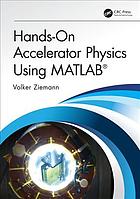Product desciption
Handson Accelerator Physics Using Matlab Ziemann Volker by Ziemann, Volker 9780429491290, 9780429957451, 9780429957468, 9780429957475, 0429491298, 0429957459, 0429957467, 0429957475 instant download after payment.
Hands-On Accelerator Physics Using MATLAB provides an introduction into the design and operational issues of a wide range of particle accelerators, from ion-implanters to the Large Hadron Collider at CERN. Many aspects from the design of beam optical systems and magnets, to the subsystems for acceleration, beam diagnostics, and vacuum are covered. Beam dynamics topics ranging from the beam-beam interaction to free-electron lasers are discussed. Theoretical concepts and the design of key components are explained with the help of MATLAB code. Practical topics, such as beam size measurements, magnet construction and measurements, and radio-frequency measurements are explored in student labs without requiring access to an accelerator. This unique approach provides a look at what goes on 'under the hood' inside modern accelerators and presents readers with the tools to perform their independent investigations on the computer or in student labs. This book will be of interest to graduate students, postgraduate researchers studying accelerator physics, as well as engineers entering the field. Features: Provides insights into both synchrotron light sources and colliders Discusses technical subsystems, including magnets, radio-frequency engineering, instrumentation and diagnostics, correction of imperfections, control, and cryogenics Accompanied byMATLAB code, including a 3D-modeler to visualize the accelerators, and additional appendices which are available on the CRC Press website
Abstract: Hands-On Accelerator Physics Using MATLAB provides an introduction into the design and operational issues of a wide range of particle accelerators, from ion-implanters to the Large Hadron Collider at CERN. Many aspects from the design of beam optical systems and magnets, to the subsystems for acceleration, beam diagnostics, and vacuum are covered. Beam dynamics topics ranging from the beam-beam interaction to free-electron lasers are discussed. Theoretical concepts and the design of key components are explained with the help of MATLAB code. Practical topics, such as beam size measurements, magnet construction and measurements, and radio-frequency measurements are explored in student labs without requiring access to an accelerator. This unique approach provides a look at what goes on 'under the hood' inside modern accelerators and presents readers with the tools to perform their independent investigations on the computer or in student labs. This book will be of interest to graduate students, postgraduate researchers studying accelerator physics, as well as engineers entering the field. Features: Provides insights into both synchrotron light sources and colliders Discusses technical subsystems, including magnets, radio-frequency engineering, instrumentation and diagnostics, correction of imperfections, control, and cryogenics Accompanied byMATLAB code, including a 3D-modeler to visualize the accelerators, and additional appendices which are available on the CRC Press website


